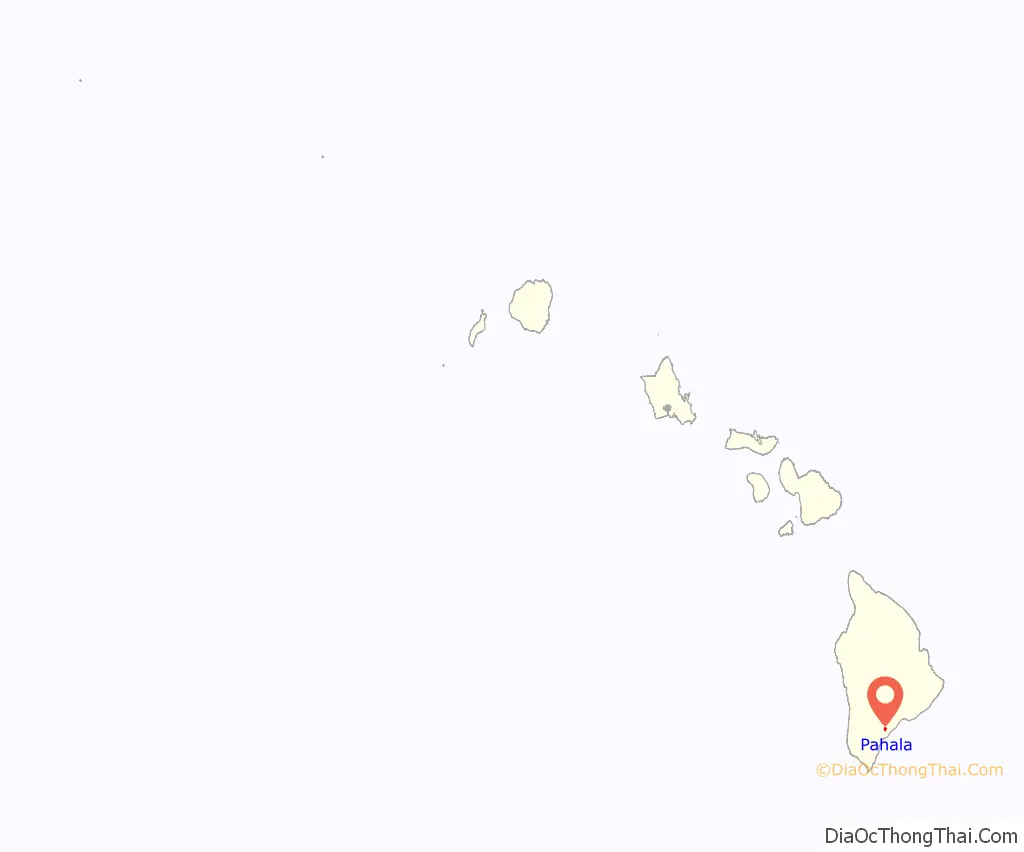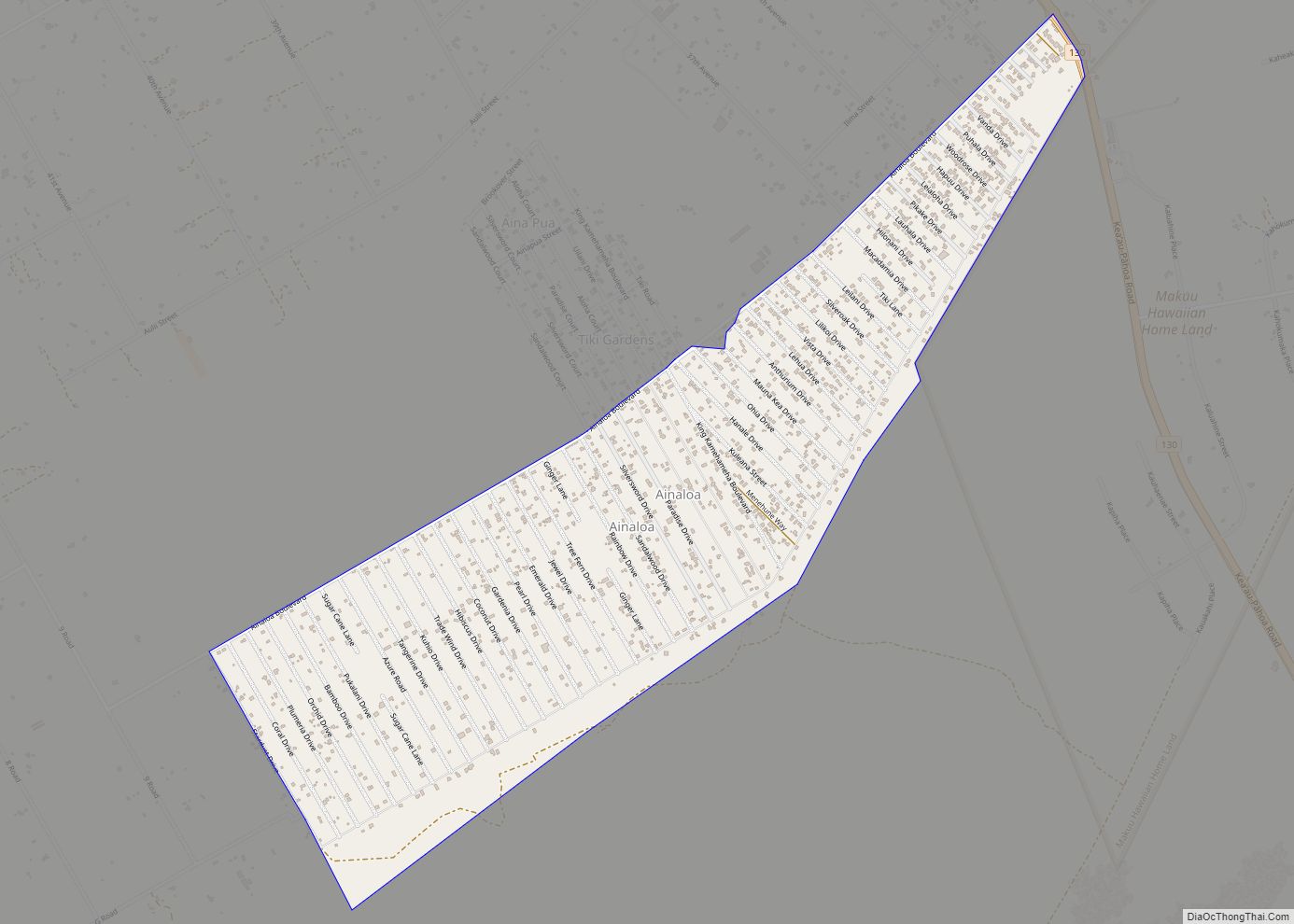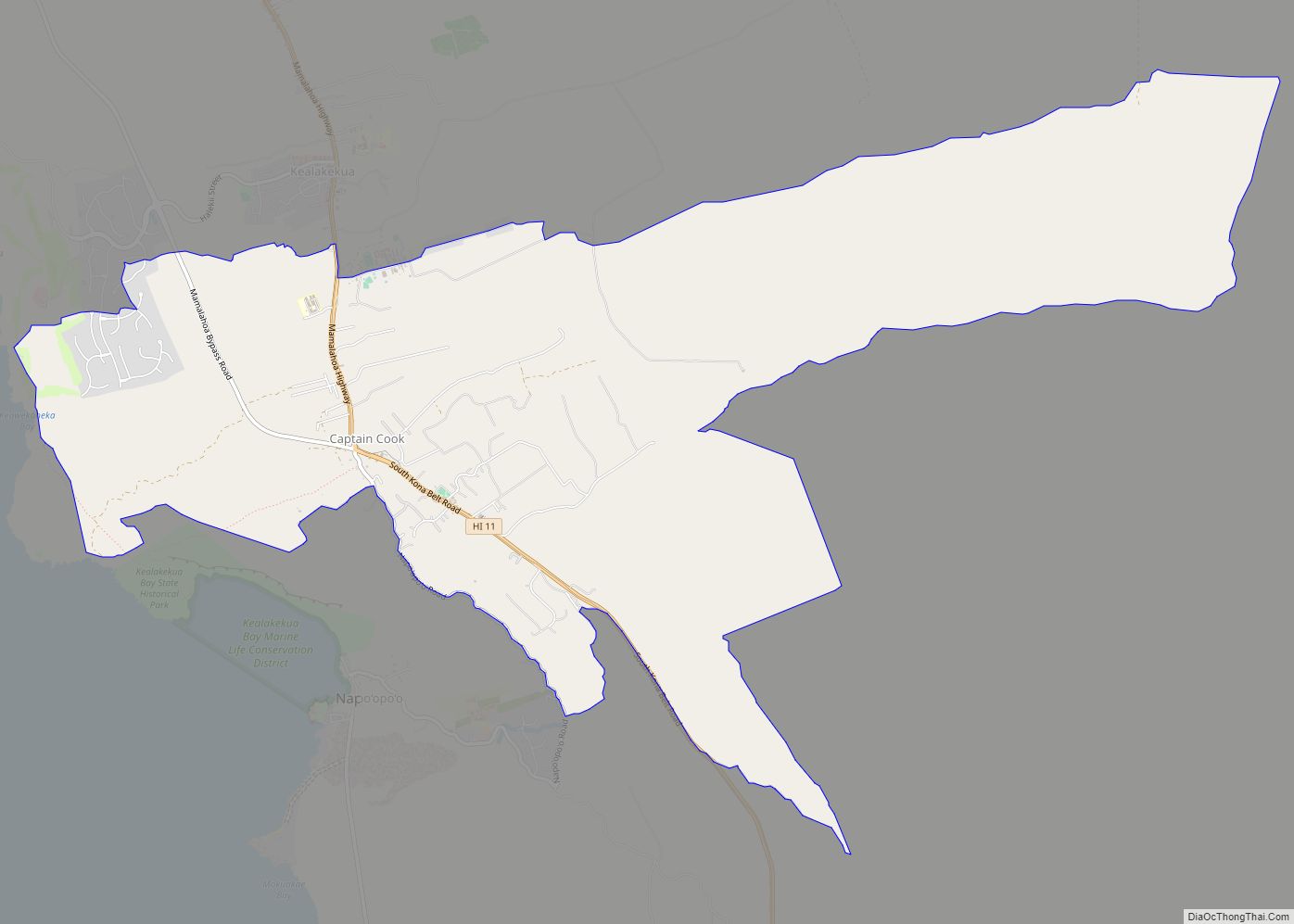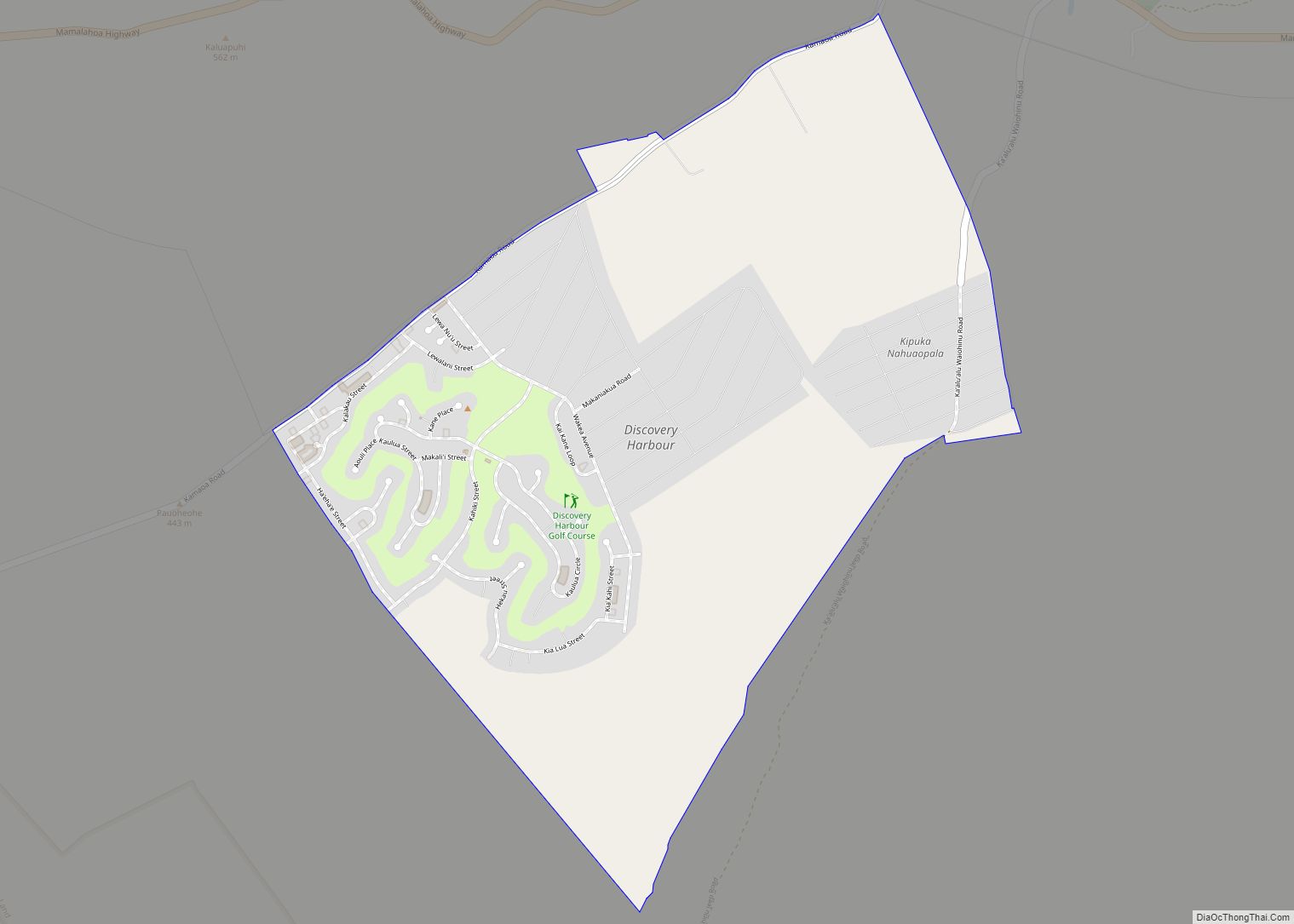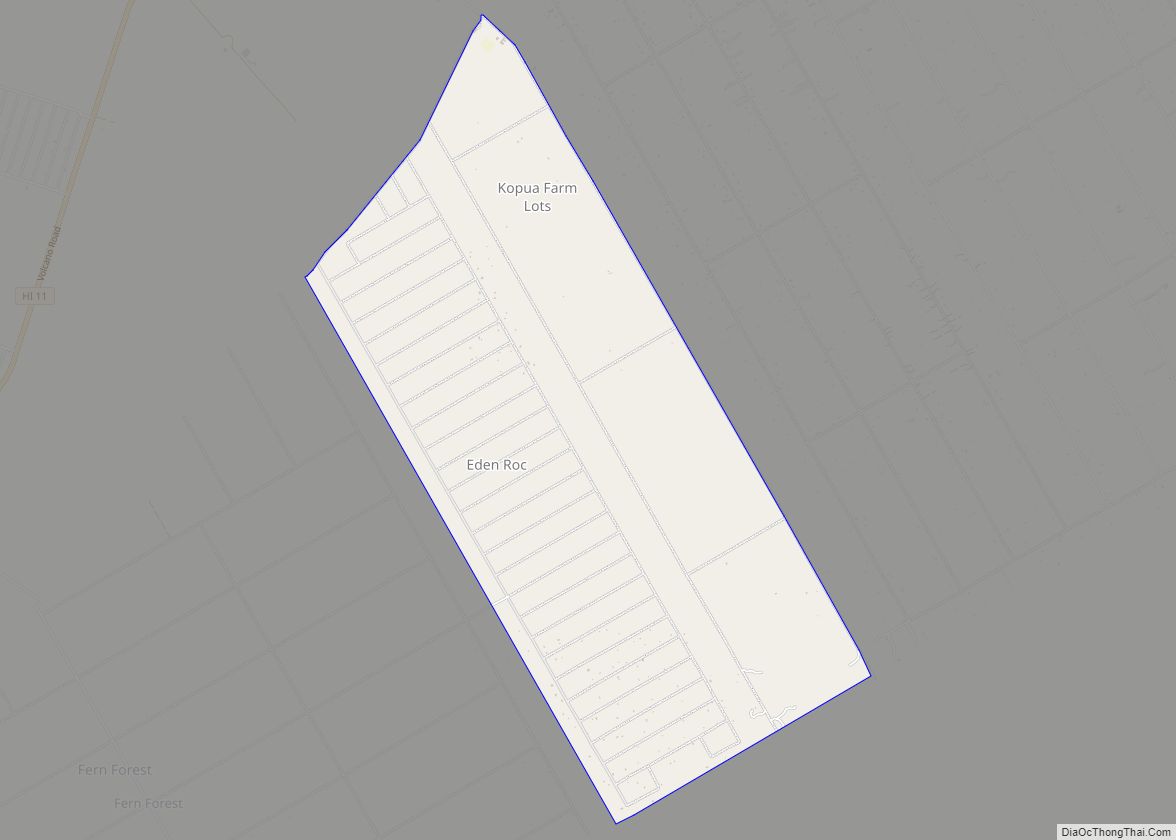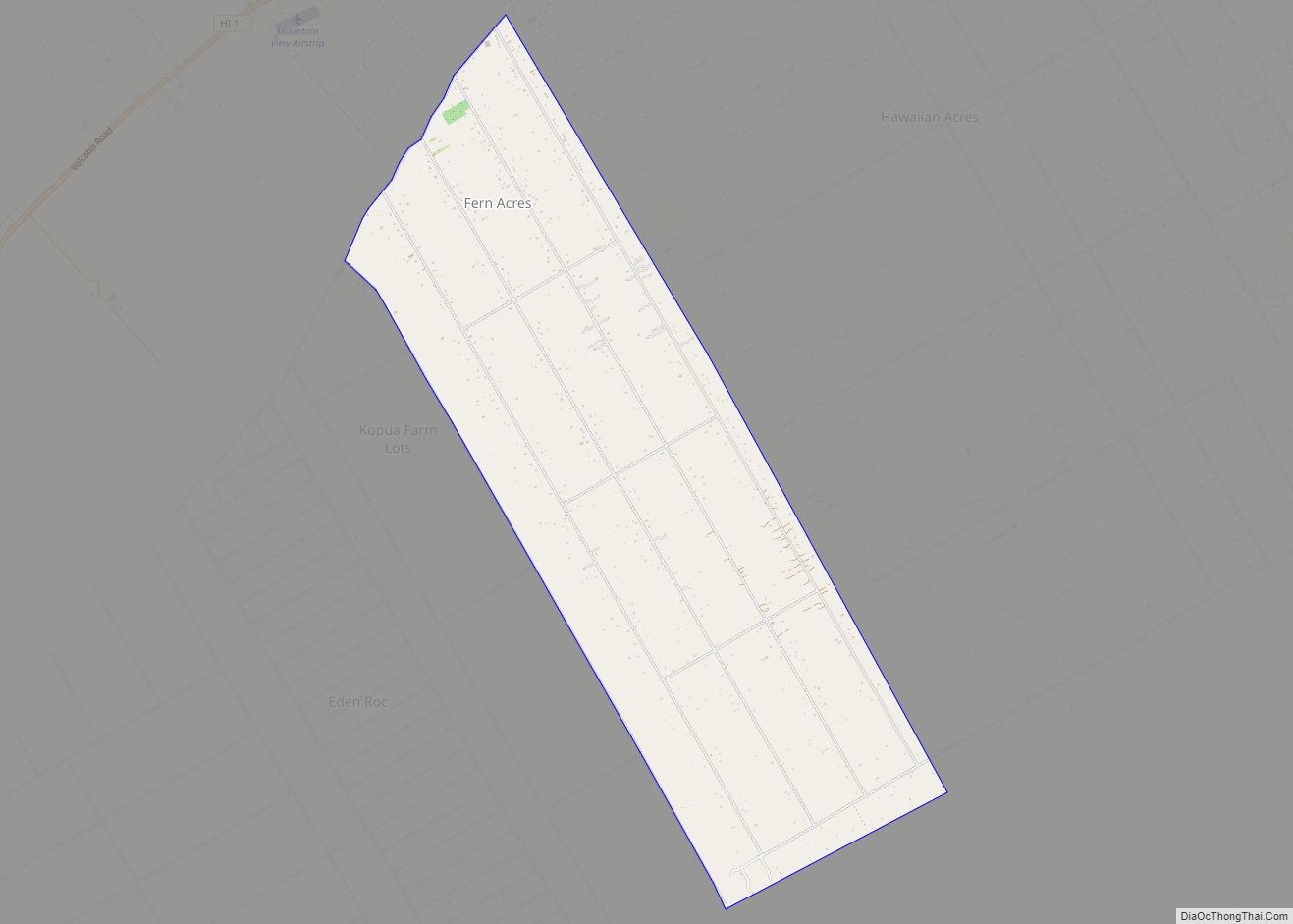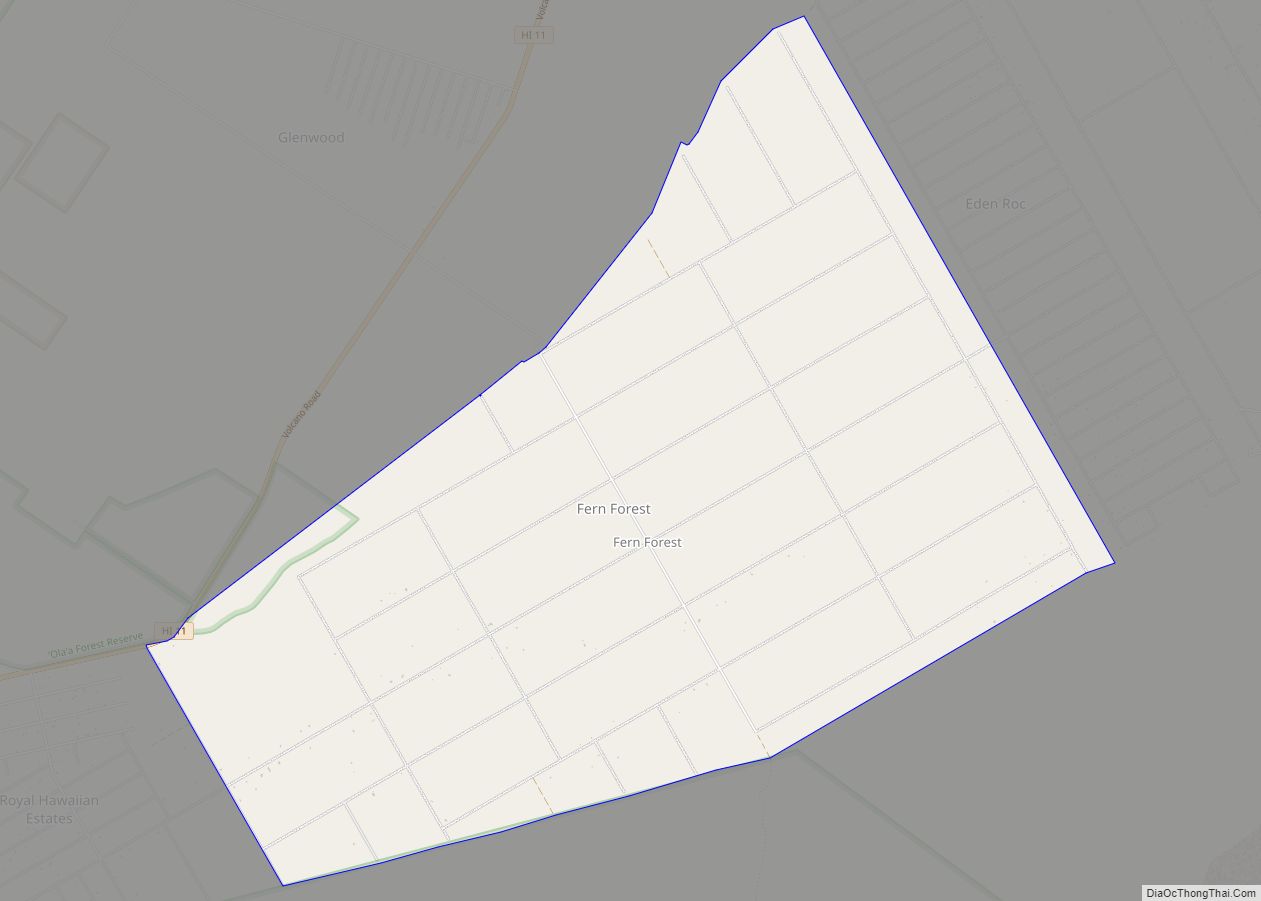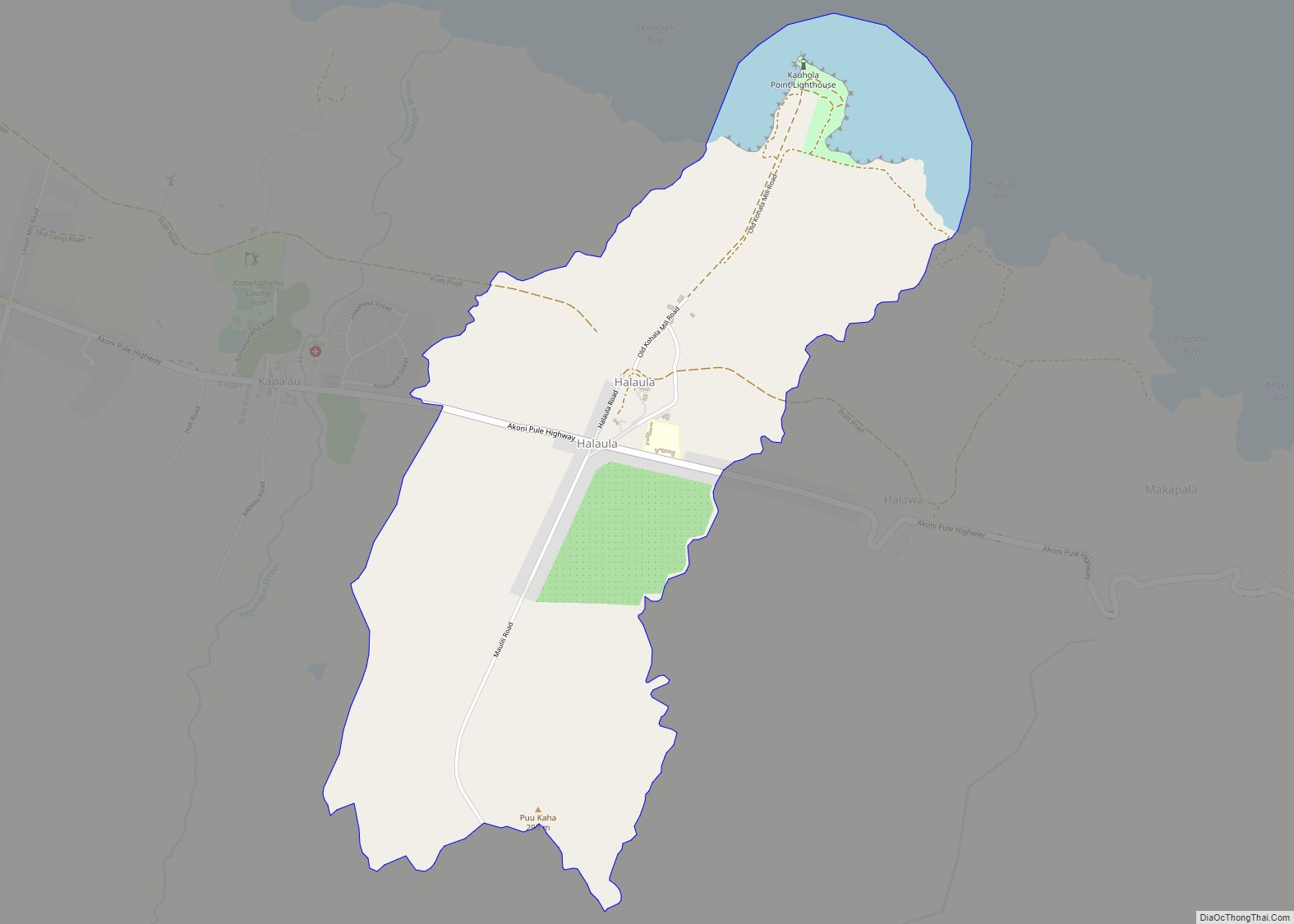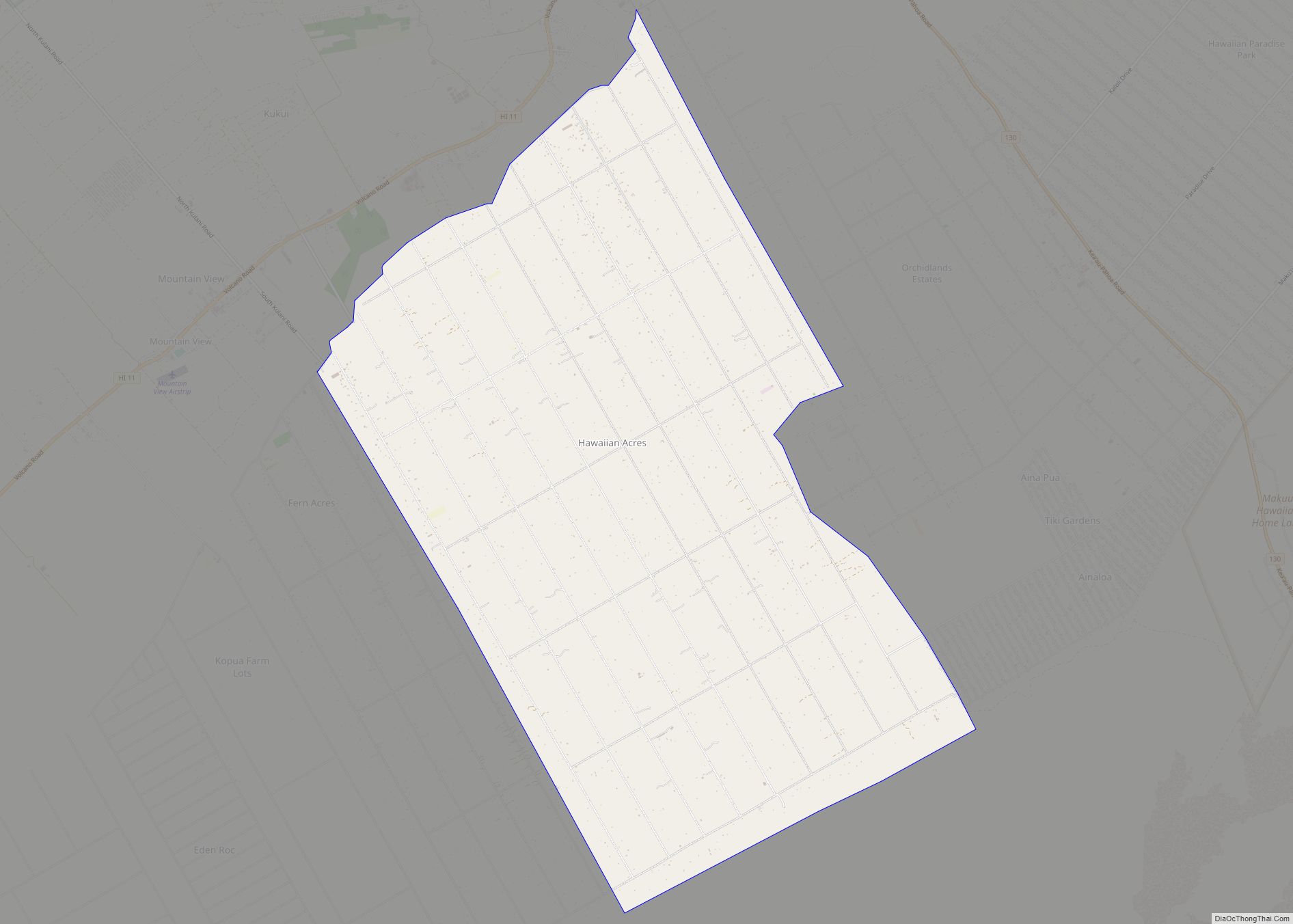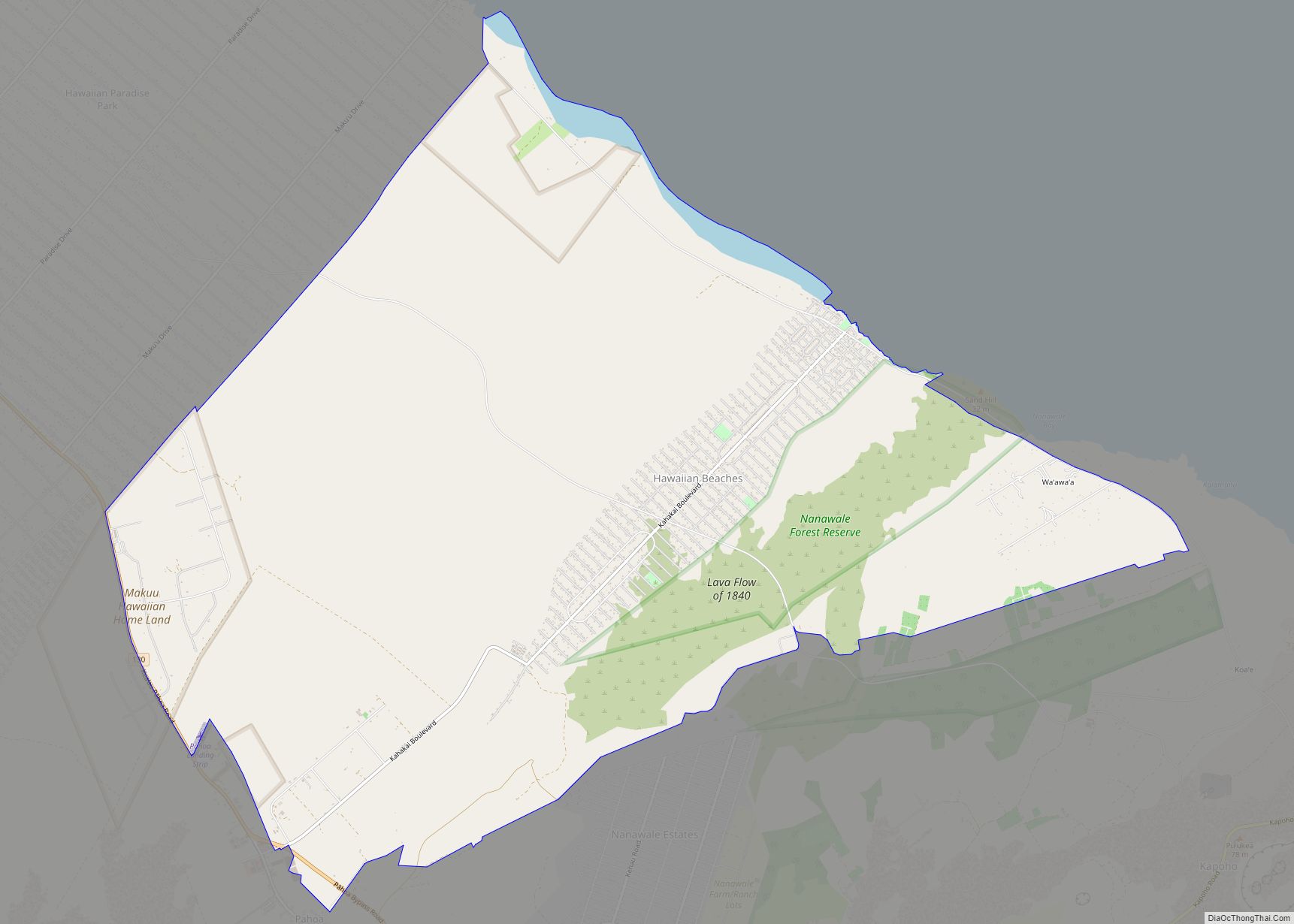Pahala is a census-designated place (CDP) in Hawaiʻi County, Hawaiʻi, United States. The population was 1,403 at the 2020 census.
| Name: | Pahala CDP |
|---|---|
| LSAD Code: | 57 |
| LSAD Description: | CDP (suffix) |
| State: | Hawaii |
| County: | Hawaii County |
| Elevation: | 920 ft (280 m) |
| Total Area: | 0.64 sq mi (1.66 km²) |
| Land Area: | 0.64 sq mi (1.66 km²) |
| Water Area: | 0.00 sq mi (0.00 km²) |
| Total Population: | 1,403 |
| Population Density: | 2,185.36/sq mi (843.28/km²) |
| ZIP code: | 96777 |
| Area code: | 808 |
| FIPS code: | 1559750 |
| GNISfeature ID: | 362938 |
Online Interactive Map
Click on ![]() to view map in "full screen" mode.
to view map in "full screen" mode.
Pahala location map. Where is Pahala CDP?
History
Pahala was created by a sugarcane plantation. The area selected to house the sugar refinery had several key features:
- a flat plateau on a sloping mountainous region
- direct access to a water well
- a strategic central location to sugarcane fields
In Hawaiian, Pāhala refers to the ashes of leaves from the hala tree (Pandanus tectorius). Long ago, when cracks were found in the sugarcane fields, workers would stuff them with hala leaves and burn them.
For years, Pahala consisted of a manager’s house, several plantation homes, a general store, and the sugar refinery. Many of the sugarcane workers were housed in small camps in and around Pahala and in camps situated throughout the outlying sugarcane fields. Many of these camps were self-sufficient. They consisted of eight to twelve plantation dwellings with a small store. Some camps had specialty shops such as a blacksmith or a simple barbershop. As time passed some installed gas stations.
In 1881, the first public school in the district of Kaʻu was established in Kapapala. The humble campus consisted of just two buildings. Some years later the school and its two buildings were relocated to Pahala and called Pahala High and Elementary School. In 1959, as Hawaiʻi Territory became the state of Hawaiʻi, the last class of the Pahala High School held commencement ceremonies. The school then became Kaʻū High and Pahala Elementary School. It is the second oldest public school in the state of Hawaiʻi, behind Lāhaināluna School in Lāhainā. Still in use today at Kaʻū High is Kapono Building, the oldest public school building west of the Rocky Mountains. The only other public school in the district of Kaʻū is Nāʻālehu Elementary. Nāʻālehu once had a high school. Today, students attend grades kindergarten through 6th grade in Nāʻālehu.
As time progressed, Pahala became the focal town of the northeastern side of the district of Kaʻū; Nāʻālehu became the other focal town to the south of the district. Businesses from outer camps migrated to Pahala to set up shop. With social and economic changes came the demands for convenience. Soon, more stores opened up. A bank and gas stations were built. For leisure, a town hall or “Club House” was built and used by the plantation and the community to hold meetings and parties. In the early 1940s Pahala Theatre was built.
By the early 1960s, C. Brewer & Co. had decided to phase out all of the camps and move homes and other structures to Pahala. At this time C. Brewer explored other alternatives to diversify into, eventually settling on macadamia nuts. Considered a weed in their native Australia, macadamia trees flourished into a new niche market for Hawaiʻi.
The early 1970s demonstrated how influential the world’s economy can be to Pahala. The 1970s brought about fuel shortages, and developing nations began to produce cheaper sugar. During the 1970s C. Brewer proposed the perfect opportunity to diversify. A gentleman by the name of Bob Shleser had proposed to Doc Buyers (then CEO of C. Brewer) the idea and technology to convert the Pahala Sugar Mill to produce ethanol fuel from sugarcane. Shleser also proposed that Hawaiʻi County pass a bill that would require 25% of all vehicles on the island to be retrofitted to use ethanol by 1985. Doc Buyers, however, decided against it.
By the late 1970s, with sugar’s looming demise, C. Brewer instead decided to expand its macadamia nut operations. They began to phase out sugarcane fields that encircled Pahala, converting them to grow macadamia trees.
By the mid 1980s it was apparent that sugar had seen its heyday. Honuʻapo’s mill had closed in 1972 and its workers transferred to Pahala. But other sugarcane plantations around the island began to close as well. Still, the Pahala Sugar Mill continued to produce record tons per acre, but at a steep price. At the time it cost $1.50 to produce 1 lb (0.45 kg), which would then sell for $0.60. Congress had proposed bills that placed huge tariffs and taxes on imported sugar. But economically, even those measures could not stave off the inevitable.
In the 1990s, it was all too evident that sugarcane had lost its lustre. C. Brewers’ investors were getting older and demanded Doc Buyers cut their losses and liquidate. In 1994, Buyers made a last-ditch effort to keep the mill running. But it required all workers to take drastic pay cuts; most would have had to accept minimum wage. The workers refused. That sealed the fate of the sugar legacy in Pahala. The last sugarcane was hauled and processed at the mill. Over the next two years the mill was dismantled and sold as parts to other manufacturing plants around the world. The sugarcane plantation and mill shut down in April 1996.
Many who lived and worked in Pahala moved on to other jobs around the island. Some took jobs in the hotel industry. Some commute up to five hours a day to and from jobs at resorts along the Kohala coast. Some moved to Maui and Kauaʻi and worked at sugarcane plantations there. Others moved to the mainland to try a fresh start. Many old timers that have generations of family ties to Pahala had passed on. Many in the younger generation have chosen not to return.
Still, there are those that have found their roots and figured out a way to remain in Pahala. In fact, unlike many other places where the larger plantation homes were purchased by outsiders coming to live in Hawaiʻi, the manager homes in Pahala were mostly purchased by local people who have stepped up to the new economy and have such jobs as doctor, bakery manager, fisherman, policeman, painting contractor and other jobs important to the community. Some new people have also moved in, restored the historic homes and established their roots, and now call Pahala home.
There has also been a movement to preserve the shoreline near Pahala, called the Kaʻū Coast, which is the longest uninhabited coast in Hawaiʻi. Its 80 miles (130 km) now include 235 acres (95 ha) of oceanfront park, for which the community raised more than $4 million to purchase and set aside forever. Another 750 acres (300 ha) along the coast called Kawa is likely to be preserved. Inland, more than 115,000 acres (470 km) have been added to Hawaiʻi Volcanoes National Park, which now circles Pahala in the mountains above the village.
Pahala Road Map
Pahala city Satellite Map
Geography
Pahala is located in the southern part of the island of Hawaiʻi at 19°12′15″N 155°28′44″W / 19.204109°N 155.479005°W / 19.204109; -155.479005. Hawaii Route 11 forms the southeast border of the community. The highway leads northeast 52 miles (84 km) to Hilo and southwest 12 miles (19 km) to Nāʻālehu. The main entrance to Hawaiʻi Volcanoes National Park is 23 miles (37 km) to the northeast of Pahala on Route 11.
According to the United States Census Bureau, the CDP has a total area of 0.85 square miles (2.2 km), all of it land.
See also
Map of Hawaii State and its subdivision: Map of other states:- Alabama
- Alaska
- Arizona
- Arkansas
- California
- Colorado
- Connecticut
- Delaware
- District of Columbia
- Florida
- Georgia
- Hawaii
- Idaho
- Illinois
- Indiana
- Iowa
- Kansas
- Kentucky
- Louisiana
- Maine
- Maryland
- Massachusetts
- Michigan
- Minnesota
- Mississippi
- Missouri
- Montana
- Nebraska
- Nevada
- New Hampshire
- New Jersey
- New Mexico
- New York
- North Carolina
- North Dakota
- Ohio
- Oklahoma
- Oregon
- Pennsylvania
- Rhode Island
- South Carolina
- South Dakota
- Tennessee
- Texas
- Utah
- Vermont
- Virginia
- Washington
- West Virginia
- Wisconsin
- Wyoming
